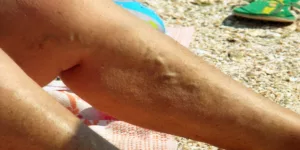For those who have experienced varicose veins, you will know that it can lead to some serious discomfort and pain and even limit your ability to do particular tasks. In saying that, if you have been unfortunate enough to have experienced varicose veins you will also know that they can be easily treated.
For those who have been lucky enough to avoid varicose veins to date, it is still important to understand the signs and symptoms as well as the preventative measures that can be put in place. Whilst they are able to be treated quickly and with little fuss, they can also lead to some more serious conditions so it is important to understand how to prevent varicose veins and also how to identify if you are suffering from the condition.
What are varicose veins?
They occur when a blood vessel no longer functions as it should due to being broken down over a long period of time. In your blood vessels there are special valves that stop the blood from running back down towards your feet via gravity to ensure that it is all able to return to your heart. In some cases these valves stop working and the blood is able to fall down and essentially pool.
This pooling of blood within the vessel causes pressure to build and can then spill out into the surrounding muscles. They cause the blood vessels in your leg to bulge and can become unattractive. For the most part, this is all they are, unattractive, but if left untreated they can lead to deep vein thrombosis (DVT) or the blood vessels and skin surrounding can harden making it extremely painful and more difficult to treat.
Signs and Symptoms
The signs and symptoms from a physical stand point are fairly obvious when it comes to varicose veins as it is more often than not clearly visible. When the blood vessel is bulging outwards and there is any sort of pain it is likely that you are suffering from the condition.
In more general terms, sufferers can experience heaviness in their legs or a dull pain both of which may mean that they are unable to partake in exercise such as running or bike riding and in more extreme cases it can limit daily output. The area around the varicose veins can also swell up increasing the pain and they may also become itchy.
Risk Factors and Preventatives
There is limited information regarding the causes of varicose veins and such the risk factors are more of a general take on the condition. However, it does appear that women are more at risk than men which is said to be due to hormones, pregnancy or the genetic makeup of the female body.
Being overweight is a major risk factor for developing varicose veins. The heavier you are, the more pressure is placed on your legs through simple activities like standing and walking. This will cause your blood vessels to have to work harder (particularly if they aren’t strengthened through fitness activities) and can lead to the unsightly condition.
Regular exercise and a healthy diet will help you to lose weight and strengthen your legs. This will help to prevent the core problems that lead to varicose veins. A good diet will also help to lower your cholesterol, which will help to reduce the pressure on your blood vessels.
It is said to run in the family and so those who have family members that have experienced varicose veins should be wary and look to the ways to prevent the condition early on in life. The last risk factor concerns those who work in professions that require them to be regularly standing for long periods of time. This includes people such as tradespeople, hairdressers and retail staff.
Finding a way to sit down and take a break regularly is a great way to reduce the risk of the condition for people in the above named professions. Additionally, living a healthy lifestyle that involves regular exercise and a healthy diet through limiting junk foods will also help to reduce the risk of varicose veins as it improves the overall health of the heart and blood vessels as well as the muscles that pump the blood around the body.








